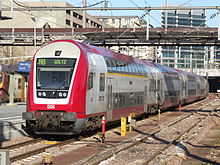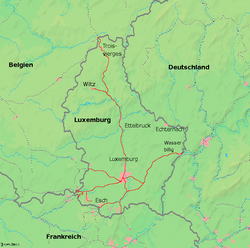Société Nationale des Chemins de Fer Luxembourgeois
| Type | Government-owned corporation |
|---|---|
| Industry | Rail transport |
| Founded | 14 May 1946 |
| Headquarters | Luxembourg City, Luxembourg |
Area served | Luxembourg, parts of Belgium, France, Germany |
Key people | Jeannot Waringo, President Alex Kremer, Director-General |
| Products | Rail transport, Cargo transport |
| Revenue | |
| Owner | 94% Luxembourg state, 4% Belgian state, 2% French state |
Number of employees | |
| Website | CFL |
| Chemins de Fer Luxembourgeois | |||||||
|---|---|---|---|---|---|---|---|
 CFL Dosto regional train in Luxembourg. | |||||||
| Operation | |||||||
| National railway | Chemins de Fer Luxembourgeois | ||||||
| Statistics | |||||||
| Ridership | |||||||
| Passenger km | |||||||
| Freight | |||||||
| System length | |||||||
| Total | 617 km (383 mi) | ||||||
| Double track | 140 km (87 mi) | ||||||
| Electrified | 574 km (357 mi) | ||||||
| Track gauge | |||||||
| Main | 1,435 mm (4 ft 8+1⁄2 in) | ||||||
| High-speed | 1,435 mm (4 ft 8+1⁄2 in) | ||||||
| Electrification | |||||||
| 25 kV 50 Hz AC | 528 km (328 mi) | ||||||
| 3 kV DC | 48 km (30 mi) | ||||||
| |||||||
The Société Nationale des Chemins de Fer Luxembourgeois (Luxembourg National Railway Company, abbreviated CFL) is the national railway company of Luxembourg. In 2013, it carried approximately 25 million passengers and 804 million tonnes of goods. The company employs 3,090 people, making CFL the country's seventh-largest corporate employer.[3]
The Luxembourg rail system comprises 275 route-kilometres (170 miles), of which 140 kilometres (87 mi) is double track and 135 kilometres (84 mi) single track. Of the total track length of 617 kilometres (383 mi), 574 kilometres (357 mi) are electrified. Most of the electrified track (526 kilometres (327 mi)) is operated at 25 kV, 50 Hz, though some 48 kilometres (30 mi) are run at 3 kV DC.
Luxembourg borders Belgium, France and Germany. Correspondingly, there are cross-border services into these countries. Some are wholly run by CFL, whereas others are run by SNCF, NMBS/SNCB and DB. CFL passenger trains cover most of the network.
CFL operates most of its passenger trains using EMUs and electric locomotives with push-pull stock. The company also has a fleet of diesel locomotives for hauling freight trains and for general shunting purposes.
Luxembourg is a member of the International Union of Railways (UIC). The UIC Country Code for Luxembourg is 82.
History[]
CFL is the result of a nationalisation of private railway companies in 1946.
CFL operations and services[]
Passenger train routes[]

CFL advertises its passenger network as made up of seven lines:[4]
- Line 10 Luxembourg – Troisvierges-Frontière – Liège (Belgium), Kautenbach – Wiltz and Ettelbrück – Diekirch
- Line 30 Luxembourg – Wasserbillig-Frontière – Trier (Germany)
- Line 50 Luxembourg – Kleinbettingen-Frontière – Brussels (Belgium)
- Line 60 Luxembourg – Esch-sur-Alzette – Rodange, Bettembourg – Volmerange-les-Mines (France), Noetzange – Rumelange and Esch-sur-Alzette – Audun-le-Tiche (France)
- Line 70 Luxembourg – Rodange – Athus (Belgium), Rodange – Longwy (France)
- Line 90 Luxembourg – Thionville (France) – Metz (France) – Nancy (France)
Internally it uses a different system with more sub divisions:[5]
- Ligne 1 Luxembourg – Troisvierges-Frontière, 1a Ettelbruck – Diekirch, 1b Kautenbach – Wiltz
- Ligne 2a Kleinbettingen – Steinfort, 2b Ettelbruck – Bissen
- Ligne 3 Luxembourg – Wasserbillig-Frontière via Sandweiler-Contern
- Ligne 4 Luxembourg – Berchem – Oetrange, 4a Luxembourg - Alzingen
- Ligne 5 Luxembourg – Kleinbettingen-Frontière
- Ligne 6 Luxembourg – Bettembourg-Frontière, 6a Bettembourg – Esch/Alzette, 6b Bettembourg – Dudelange-Usines (Volmerange), 6c Noertzange – Rumelange, 6d Tétange – Langengrund, 6e Esch-sur-Alzette – Audun-le-Tiche, 6f Esch-sur-Alzette – Pétange, 6g Pétange – Rodange-Frontière (Aubange), 6h Pétange – Rodange-Frontière (Mont St. Martin), 6j Pétange – Rodange-Frontière (Athus), 6k Brucherberg – Scheuerbusch
- Ligne 7 Luxembourg – Pétange
Rail links to adjacent countries[]
All neighbouring railways use the same gauge but differing electrification types, listed below:
Ridership[]
Passenger ridership carried on CFL-trains for each fiscal year (x 1000).[6]
- 1938: 9,505
- 1950: 10,607
- 1960: 10,643
- 1970: 12,531
- 1980: 14,053
- 1990: 12,692
- 2000: 12,985
- 2006: 14,793
- 2007: 16,442
- 2008: 17,676
- 2009: 17,039
- 2010: 17,996
- 2011: 18,200
- 2012: 19,834
- 2013: 20,714
- 2014: 21,503
- 2015: 22,496
- 2016: 22,459
- 2017: 22,930
- 2018: 23,331
- 2019: 25,016
Passenger kilometers on CFL-trains for each fiscal year (x 1,000,000).[6]
- 1938: 215
- 1950: 227
- 1960: 230
- 1970: 256
- 1980: 302
- 1990: 261
- 2000: 332
- 2006: 298
- 2007: 233
- 2008: 345
- 2009: 333
- 2010: 347
- 2011: 349
- 2012: 373
- 2013: 385
- 2014: 409
- 2015: 418
- 2016: 417
- 2017: 438
- 2018: 443
- 2019: 463
Rolling stock[]

CFL owns a relatively modern fleet of passenger trains, with a majority of double-decker trains. Nearly all routes are operated with electric trains.
Projects[]
In 2019, doubling of track between Luxembourg railway station and Sandweiler-Contern at a cost of €462 million was completed, following an original planned 2013 opening.[7] A new, more direct, line between Luxembourg and Bettembourg is due to open in 2024.[8]
See also[]
Footnotes[]
- ^ "Rapport annuel 2013". Chemins de Fer Luxembourgeois. 2014. Retrieved 13 January 2015.
- ^ "Railway passenger transport statistics" (PDF). Europa EU. 8 December 2019. Retrieved 9 January 2021.
- ^ "Les principaux employeurs luxembourgeois au 1.1.2007" (PDF) (in French). Statec. 24 May 2007. Archived from the original (PDF) on 11 June 2007. Retrieved 21 July 2007.
- ^ "CFL | Réseau & Gares". www.cfl.lu. Retrieved 30 August 2020.
- ^ "RESEAU FERRE LUXEMBOURGEOIS, DOCUMENT DE REFERENCE 2008" (PDF) (in French). Chemins de Fer Luxembourgeois. 2007. Retrieved 27 September 2007.
- ^ Jump up to: a b "Trafic voyageurs (rail et route) 1938 - 2019 (version révisée)". statistiques.public.lu. Retrieved 27 November 2020.
- ^ "€462m rail link hopes to ease Luxembourg traffic flow". Luxembourg Times. 12 June 2019.
- ^ "Luxembourg to invest €4bn in railway infrastructure". Luxembourg Times. 18 July 2018.
External links[]
| Wikimedia Commons has media related to Société nationale des chemins de fer luxembourgeois. |
- (in French) CFL official website
- (in French) 2006 Annual Report
- Collection of Google Earth locations of CFL stations (Requires Google Earth software) from the Google Earth Community forum.
- Railway companies of Luxembourg
- Chemins de fer luxembourgeois locomotives
- Government-owned companies of Luxembourg
- Companies based in Luxembourg City
- Railway companies established in 1946
- 1946 establishments in Europe
- 1946 in Luxembourg

